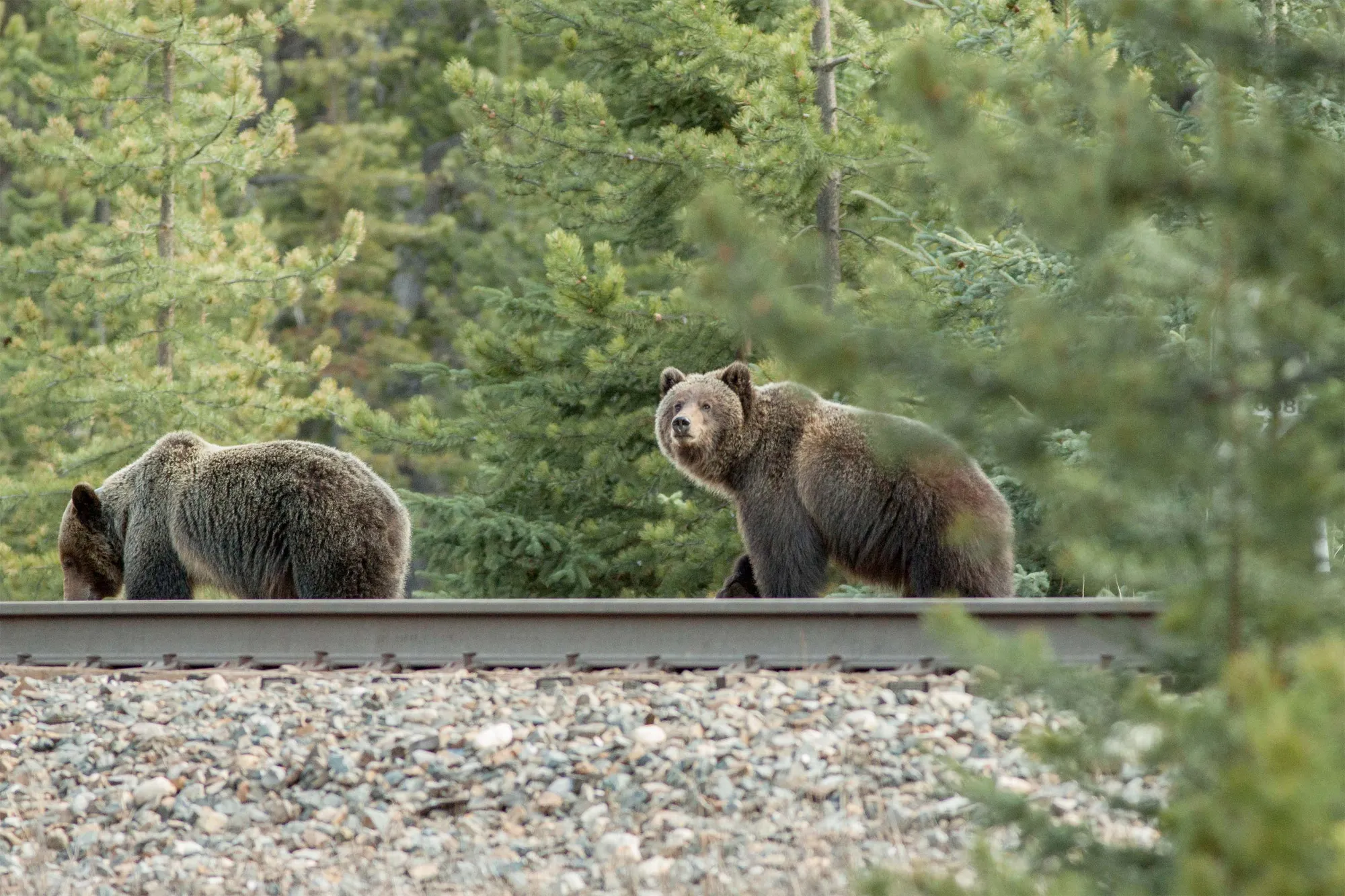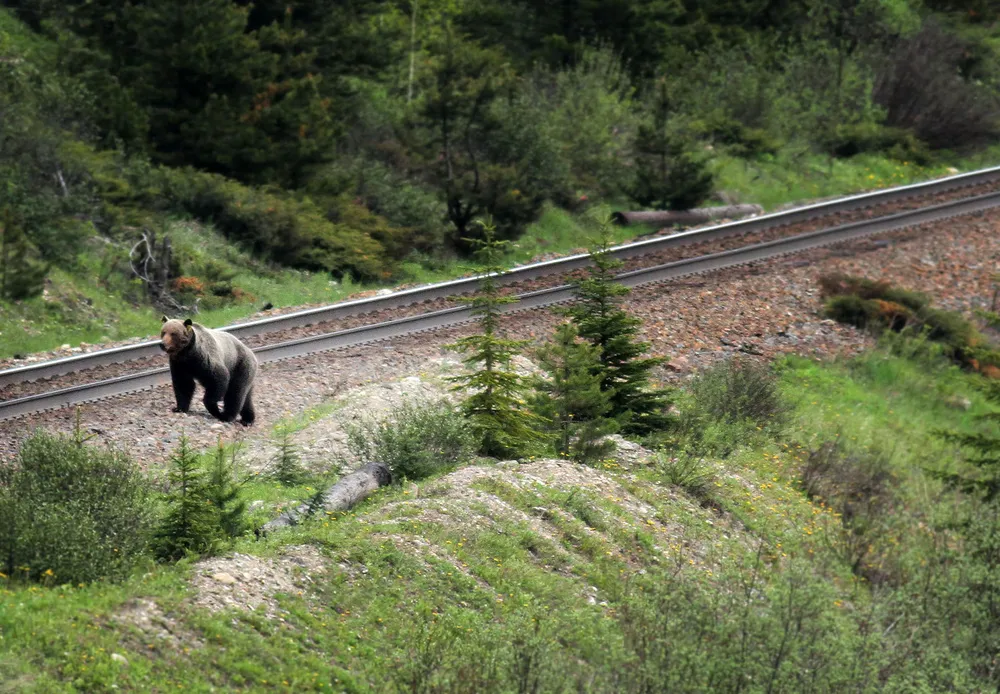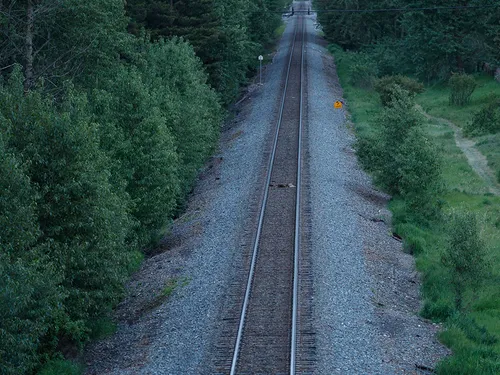
Researchers designed an alert to prevent trains from killing animals. Why aren’t we using it?
Across the country, scores of animals are killed on the railway every year. Trains are a major cause of death for grizzly bears in places like Banff National Park in Alberta and B.C.’s Elk Valley. They’ve killed moose in northern Ontario and pronghorn antelope in the Prairies.
Inconsistent monitoring makes it challenging to know exactly how many animals are killed nationwide, but railways take a significant toll in some areas. At a time of increasing pressure on wildlife from habitat loss, the spread of disease and the impacts of climate change, finding ways to prevent collisions could offer a desperately needed win for wildlife.
And, there are potential solutions. Take an early warning system developed by researchers at the University of Alberta about a decade ago. Like the railroad crossings people encounter on roads, the system uses a dinging noise and flashing lights to alert wildlife to an approaching train about 30 seconds before it arrives.
Trials in Banff National Park between late-2016 and mid-2017 showed large animals like coyotes, elk and grizzly bears fled the railway about six and a half seconds sooner when alerted by the early warning system — seconds that can mean the difference between life and death.
It’s compelling evidence this type of system can help reduce collisions, according to University of Alberta ecologist Colleen Cassady St. Clair. She worked with Jonathan Backs, who combined his expertise in engineering and ecology to develop the system.
But as far as St. Clair knows it still isn’t being used in Canada. She said there just isn’t enough public attention on the issue to push governments and railways to confront it on a broad scale.
“That’s very different from the highway situation, where public pressure from injuries and property damage has been an immense part of the wildlife mitigation,” she said.
The early warning system was developed out of a five-year grizzly bear research initiative launched in 2010 with a $1-million grant from Canadian Pacific, the railway company now known as Canadian Pacific Kansas City or CPKC. The project was a joint initiative with Parks Canada, focused on rail-wildlife collisions in two national parks straddling the B.C.-Alberta border, Banff and Yoho.
St. Clair saw this convergence between three Canadian icons — Banff National Park, the railway and grizzly bears — as a unique opportunity to study a problem that plagues wildlife across the country and around the world.
The team’s goal was to understand the root cause of collisions, particularly between trains and bears, and to suggest ways to reduce them.

Between 1995 and 2018, 47 black bears, 15 wolves, 12 grizzlies, 328 elk, 116 whitetail deer and 66 mule deer were hit and killed by trains in the corridor, according to a 2020 study published in the journal Nature by St. Clair and her co-authors.
For wildlife, railways offer both an easy travel corridor and plenty of food. Light-loving plants like dandelions and buffalo berries grow alongside the tracks and significant amounts of grain leak from passing trains. In one 2017 study, researchers, including St. Clair, estimated about 100 tonnes of grain leak annually along a 134-kilometre stretch of railway inside Yoho and Banff national parks. That’s enough to feed about 50 bears for a year.
In a statement to The Narwhal, CPKC spokesperson Terry Cunha said the company has replaced about 6,000 older grain cars in the past several years and noted clean-up crews respond in the “rare event” of a spill.
Train speed, animal personalities, soundscapes can all factor into collisions
St. Clair said the grizzly bears her team monitored in Banff didn’t seem particularly drawn to grain. But grain is attractive to elk and deer and when those animals were hit by trains, their carcasses drew in the bears.
Only a few grizzlies the team monitored with GPS collars used the railway regularly, St. Clair said. And the two most frequent users were, in some ways, polar opposites.
Bear 122, known colloquially as The Boss, seemed to have figured out that trains kill a lot of elk and deer, making it an easy place to find protein, she said. But he is also a “very shrewd bear” and “he seems to have a lot of respect for trains.”

Bear 128, who was orphaned as a two-year-old when his mother was killed by a train, also relied on the railway for food. But he never seemed to quite grasp the risks of fast-moving vehicles and was eventually killed by a truck on the highway, she said.
“The Boss is this phenomenally successful bear eating a lot of protein and 128 was this feeble little teenager that was barely eking out an existence,” St. Clair said.
In an interview over Zoom, she showed a photo of Bear 128 and another bear, 126, on a railway. Bear 126 has its head up, alert, as if reacting to a noise, but 128 has his head down seemingly focused on eating, she explained.
It’s just an anecdote, St. Clair said, but it speaks to how personality differences among individual animals can affect their fate in risky landscapes.
At the same time, the researchers learned there are “acoustic contexts” where a moving train can almost sneak up on you — places where there’s a lot of background noise, for example, or mountains that block the sound of a train as it moves around a bend. This makes collisions more common, the researchers found, as do spots where tracks run alongside water, limiting escape routes.
But the biggest predictor they found is train speed.
St. Clair recounted the panicked reactions of bears as a train chugged toward them in videos taken from the front of locomotives. “They would bolt down the tracks and not be able to outrun a train,” she said.
The idea behind the early warning system was that some animals needed more time to detect a train, understand the danger and evade it by getting off the tracks.
And it doesn’t need to be a scary sound, St. Clair said, just a unique one animals would eventually learn to associate with an approaching train.
Trials of the early warning system in Banff showed it’s “a mitigation that could work,” she said.
No clear commitment from governments or railways to adopt early warning systems
While experiments with Backs’s prototypes, which cost about US$225 in materials in 2017, showed the early warning system’s potential for reducing collisions, St. Clair said better monitoring is needed to identify locations where it could have the greatest impact. The system itself would likely require further research and development before it could be widely deployed, she added. The challenge from her perspective is the railways don’t seem motivated to make the required investments voluntarily, and so far, governments haven’t required them to.
Neither Canadian National Railway (CN) nor CPKC agreed to be interviewed by The Narwhal. Instead both companies sent brief statements in response to emailed questions.
CPKC spokesperson Terry Cunha said the company works with Parks Canada, the B.C. government and other experts to reduce wildlife conflict.
He said CPKC manages vegetation to reduce plants that might attract animals, improve wildlife sight-lines and give animals room to safely get off the tracks.
He did not say whether CPKC is exploring expanded trials of the early warning system.
Loading...
- CN
- CPKC
- Others
CN spokesperson Ashley Michnowski said the company monitors collisions and shares data with governments as required.
“We continue to invest in technology and work closely with government agencies to ensure safe, sustainable operations across our network,” Michnowski said, though she did not address questions about the early warning system specifically.
She said the company works to reduce wildlife mortality by building crossings and removing old telegraph lines and has targeted initiatives in places like Jasper National Park and northern B.C., where CN has led a wildlife mortality working group for more than 15 years.
The Narwhal also asked B.C.’s Ministry of Water, Land and Resource Stewardship if the provincial government is exploring the use of early warning systems to prevent train-wildlife collisions and if it would require railways to use such a system. In response, a spokesperson for the ministry directed The Narwhal to the federal government. According to Transport Canada, “There are no specific requirements under the Railway Safety Act focused solely on train-wildlife collisions.”
Train-wildlife collisions call for ‘creative solutions’
There are other potential solutions which could be deployed, including cleaning up grain leaks and animal carcasses that draw other wildlife to the tracks.
In Banff, Parks Canada cleared 50 kilometres of wildlife trails to create and enhance alternative travel routes for bears near high-risk sections of railway tracks and is using remote cameras to monitor animal use. A spokesperson for the federal agency called preliminary results “promising.”
In northern B.C., meanwhile, concerns about moose mortality spurred the creation of the working group in 2007 that brought the provincial government, CN, academics and local groups together to study the problem between Smithers and Endako.
Documents obtained by The Narwhal through a freedom of information request show surveys were used to count moose kills along a 200-kilometre stretch of track. Numbers were highest in heavy snow years: 155 dead moose were counted in the winter of 2014-15, which had the highest snowfall in eight years of monitoring. The following winter, one of the mildest snow years, that number dropped to about 36, according to the reports.


Fencing built along 6.8 kilometres of railway to keep moose off the tracks helped reduce, but not eliminate, collisions in that area. Moose were still able to access the tracks where the fencing ended — a challenge the working group was looking to address with wildlife guards made of stiff plastic board, the documents show.
Short sections of fencing, particularly in high-risk collision areas could be part of a package of solutions deployed across a landscape, St. Clair said, though fence ends can pose a challenge.
While widespread fencing and safe crossings could reduce train-wildlife collisions, as they have along highways, some experts say the high expense may be harder for governments to justify when there’s little risk to human life or property. Highway collisions endanger people too, and carry a high cost for insurers.
And in some areas, the railway is tucked up against rivers or canyon walls that would make fencing a particular challenge, wildlife scientist Clayton Lamb said. Fencing and crossing structures can also restrict species movement across the landscape, which carries its own set of challenges.
“It kind of begs for other creative solutions,” Lamb said.
He sees the potential for an early warning system to help reduce grizzly bear collisions in the Elk Valley. But it’s not something he can make happen alone.




